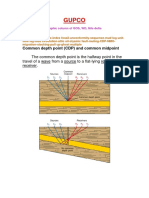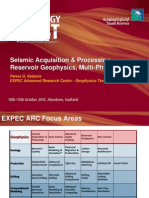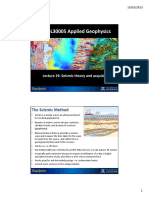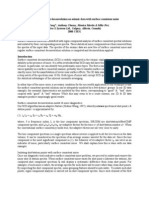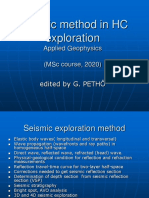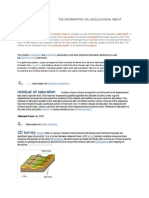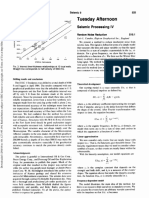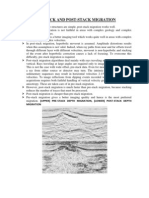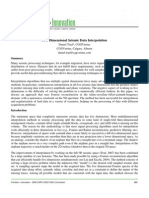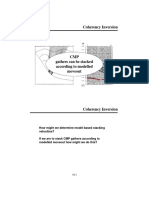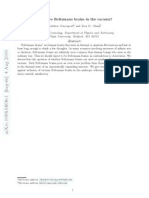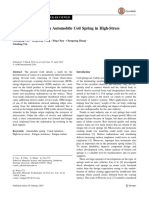Technical Note: Ardmore Field Extended Elastic Impedance Study
Technical Note: Ardmore Field Extended Elastic Impedance Study
Uploaded by
Az RexCopyright:
Available Formats
Technical Note: Ardmore Field Extended Elastic Impedance Study
Technical Note: Ardmore Field Extended Elastic Impedance Study
Uploaded by
Az RexOriginal Title
Copyright
Available Formats
Share this document
Did you find this document useful?
Is this content inappropriate?
Copyright:
Available Formats
Technical Note: Ardmore Field Extended Elastic Impedance Study
Technical Note: Ardmore Field Extended Elastic Impedance Study
Uploaded by
Az RexCopyright:
Available Formats
Technical Note:
Ardmore Field
Extended Elastic Impedance Study
http://www.sorviodvnvm.co.uk
Technical Note: Ardmore Field Extended Elastic Impedance Study 1
© 2005 Earthworks Environment & Resources Ltd. All rights reserved.
Earthworks Ltd - Company Overview
Earthworks Environment & Resources Ltd. was formed in June 2001 to provide
services and consultancy internationally to the oil and gas industry. Specialising in
subsurface geosciences, Earthworks has a broad set of skills in geophysics,
geostatistics and risk and uncertainty evaluation.
Earthworks is a specialised company offering the latest technology through staff fully
conversant with all technical aspects of the work. Our expertise and understanding
in geophysics and geostatistics is second to none and as a consequence we are also
a leading trainer to the industry in these disciplines, through courses and technical
conferences.
Based in the historic medieval town of Salisbury in the heart of the English
countryside, we offer the most modern technology and electronic communications in
ancient surroundings. We have ready access to London, the City and its
international airports, allowing Earthworks to provides services and consultancy to
any locale or operation worldwide.
Earthworks Environment & Resources Ltd
Prestex House
Edison Road
Churchfields
Salisbury
Wiltshire
SP2 7NU
Tel: 01722 343990
Fax: 01722 343991
Web: http://www.sorviodvnvm.co.uk
Technical Note: Ardmore Field Extended Elastic Impedance Study 2
© 2005 Earthworks Environment & Resources Ltd. All rights reserved.
Introduction
This technical note is a case study describing deterministic inversion work
undertaken by Earthworks on the Ardmore Field. In addition, it serves as a briefing
document on our methods of applying extended elastic impedance to predict
reservoir properties.
The seismic data used as input to this study was processed by GX Technology
EAME Ltd. Petrophysical analysis, reservoir zonation, geological cross-sections and
seismic horizon and fault interpretation were carried out by Helix RDS Limited.
Earthworks undertook the work on behalf of the operating partnership and we are
grateful for their permission to use the data published here.
Technical Note: Ardmore Field Extended Elastic Impedance Study 3
© 2005 Earthworks Environment & Resources Ltd. All rights reserved.
Overview of Extended Elastic Impedance Seismic Inversion Workflow
Our seismic inversion workflow, illustrated opposite, is based on a phased approach.
Subsequent phases depend on completion of previous phases of work. The end of
each phase is a convenient break-point at which the work and results can be
evaluated with the client and a decision made to proceed to more sophisticated
analysis in subsequent phases.
Phase 1 is a feasibility study designed to investigate the relationships between
Extended Elastic Impedance (EEI) (Whitcombe et al, 2002) and the reservoir
properties. EEI analysis includes an analysis of the correlation, as a function of
angle Chi, between EEI logs and the available petrophysical logs such as Vshale,
porosity and saturation as well as lithology logs such as gamma ray. In addition, the
optimal EEI Chi angles for predicting rock physics parameters such as Ip, Is or Vp/Vs
ratio are also checked. We also generate histograms showing EEI separation based
on a classification such as sand / shale or fluid type. These can be compared to the
separation obtained using conventional acoustic or elastic impedance to show the
improvement obtained from the EEI analysis approach.
Based on the results of the feasibility study a recommendation to proceed with EEI
inversion will be made along with a selection of Chi angles to maximise the value of
the seismic data. The Chi angles in the workflow opposite are specific to the
Ardmore Field work described in this Technical Note.
Phase 2 establishes the tie between well logs and seismic. The usual seismic input
is a set of angle stacks obtained from a pre-stack migration. Angle dependent
synthetic seismograms are calculated and are used to tie the wells to the angle
stacks. The tied logs are then used to estimate a different seismic wavelet for each
angle stack. Zero phase deconvolution is applied separately to each angle stack to
remove small time shifts and help to normalise the amplitude spectra across the
angle stacks. A common post-deconvolution bandwidth is preferred and a band pass
filter may be applied to the angle stacks at this stage. The angle stacks are then
input to our chi angle projection software and the required chi angle volumes
generated. Well ties are then checked using EEI synthetics for the appropriate chi
angles and wavelets re-estimated, either for a further de-phase or for use in
deterministic inversion in Phase 3. The final Chi volumes then form the input to
coloured inversion (Lancaster and Whitcombe, 2000). Coloured inversion converts
the seismic data to a relative impedance data set. Coloured impedance is an
excellent qualitative interpretation tool and its combination with EEI gives a product
which is optimal for a given petrophysical or lithological property.
Phase 3 provides absolute impedances through deterministic inversion. A model of
impedance is built from the wells and seismic horizon interpretation and this model is
used to constrain the subsequent inversion. Each Chi volume has a separate EEI
model and is inverted separately. Our model building method is geostatistical and
involves 3D anisotropic variogram analysis and kriging. We can offer both model-
based and sparse spike deterministic inversion according to client requirements.
Using quantitative relationships such as multi-linear regression or fuzzy classification,
the Chi volumes can be combined to provide optimal reservoir property prediction
volumes.
Finally it should be mentioned that the EEI workflow can also be used as input to our
stochastic inversion technology, which is described in a separate technical note.
Technical Note: Ardmore Field Extended Elastic Impedance Study 4
© 2005 Earthworks Environment & Resources Ltd. All rights reserved.
EEI Seismic Inversion Workflow (Ardmore)
Phase 1
Well Log EEI Analysis for Lithology,
Preparation porosity, saturation prediction
Phase 2
Well/Seismic Tie & Wavelet Estimation
Angle 0-10 o 10-20o 20-30o
Stacks
Zero Phase Deconvolution
0-10 o 10-20o 20-30o
Selected
EEI Projection to Chi Angles
Chi Angles
Chi(-65 o) Chi(18o) Chi(23 o)
Check Phase/Tie & Chi(-65 o)
Coloured
Re-Estimate Wavelets Chi(18o)
Chi(23 o) Inversion
Phase 3 Chi(-65 o) Chi(18o) Chi(23 o)
Impedance Model Building
Seismic Chi(-65 o) Chi(18o) Chi(23 o)
Horizons
Deterministic Inversion
Chi(-65 o) Chi(18o) Chi(23 o)
EEI / Reservoir
Porosity & Vshale Prediction
Property Relations
Porosity Vshale
Volume Volume
Technical Note: Ardmore Field Extended Elastic Impedance Study 5
© 2005 Earthworks Environment & Resources Ltd. All rights reserved.
Description of the Ardmore Field
History
The Ardmore Field started life as the Argyll Field and was the first productive oilfield
in the UKCS with production start-up in June 1975 (Robson, 1991). The discovery
well 30/24-2 was drilled by the Hamilton Brothers on a horst feature identified at base
Cretaceous level. Further wells established oil-bearing Upper Jurassic and Devonian
sandstones. The Zechstein was the principal productive interval during the first five
years of field development and historically has produced the majority of the oil from
the field. Flow rates in excess of 16,000 BOPD were achieved from the Zechstein.
In 1979 the 30/24-11 well penetrated oil-bearing Rotliegendes sandstones in the
central part of the field. This proved to be a prolific producing interval, with flow rates
up to 11,000 BOPD. Production performance from the Devonian tended to be
poorer, although rates in excess of 5,500 BOPD were achieved. By 1991 the field
was in decline and was decommissioned in 1992.
The field was reactivated in 2002 when Tuscan Energy (Scotland) Ltd and Acorn
North Sea Ltd acquired the 30/24 and 30/25b licences. To this were added the
30/29b and 30/29c licences in the 21st licensing round in 2003. GXT Technology
merged and reprocessed two existing 3D seismic surveys in 2003 and this forms the
input to the work undertaken by Earthworks and described in this Technical Note.
After just 20 months from the grant of the licence, the operating partners announced
in October 2003 that the new T1 well was flowing at a rate of 15,000 BOPD.
Structural Setting
The Ardmore Field is located on the southwestern flank of the Central Graben.
Ardmore is situated along a NW-SE trending Palaeozoic high feature. The major
graben edge faults are to the northeast of the field and provide a seal by
downthrowing non-reservoir lithologies against the Devonian. The hydrocarbons are
trapped in a southwest dipping tilted fault block with dip closure to the south and
east. Major mid-Devonian Limestone faults are identified on the seismic and
assumed to traverse the entire Devonian stratigraphy and intersect the Base
Zechstein (see seismic section opposite).
Reservoir and Source
The major reservoir units are shown in the simplified diagram opposite. The main
producing reservoir has been the Zechstein which has excellent characteristics due
to the presence of both vuggy and fracture porosity. The Rotliegendes reservoir is
composed of good quality massive Aeolian dune sandstones and is restricted to the
central area of the field. They are generally clean sands with high net:gross ratios.
The Devonian reservoir is fair to poor quality fluvial sands, deposited in an arid
environment. Upper Jurassic shallow marine sands are also oil-bearing in Ardmore
although their contribution to total production has been small. Targeting of Jurassic
potential over the greater Ardmore area is an objective of the impedance studies.
There is also reservoir potential in the chalk, with shows and oil columns being
identified both on Ardmore and the adjacent Dalmore Field.
The source rock for all the hydrocarbons is the Upper Jurassic Kimmeridge Clay
Formation. The Kimmeridge is not mature over the field area and it is likely that the
oils have migrated from the deeper, more basinal Central Graben to the north.
Technical Note: Ardmore Field Extended Elastic Impedance Study 6
© 2005 Earthworks Environment & Resources Ltd. All rights reserved.
30/24a 30/25a
30/23
30/24c
30/24,
Satellite I
30/25b 2002
30/24b
Dalmore Ardmore
30/25b
30/24d
30/28 30/29c 30/30
Iris
30/29b, 30/29c
21st Round 30/29b
2003
5km
30/29a
Licensees
Licensees:
Tuscan Energy (Scotland) (Op, 65%)
Acorn North Sea&
Acorn Oil Gas (100%)
(35%)
30/24-34 well
SW NE
Base Zechstein Seismic event (Peak) Northern Boundary of Ardmore and extent of
seismic interpretation
East Central Graben
SW – NE
Devonian stratigraphy is
seismically transparent
A higher level of confidence is
attached to the Northern Block
Bounding Fault traversing the
Devonian and intersecting the
Base Zechstein
Mid Devonian Limestone Seismic event (Trough)
Faults assumed to traverse the
whole Devonian Stratigraphy and
intersect the Base Zechstein
Major Mid Devonian Limestone
faults clearly seen on seismic
Originally prepared by Helix RDS on behalf of Tuscan Energy
Southern Ardmore Central Ardmore Northern Ardmore
30/24b-T1 30/24-02 30/24-09 30/24-20Z 30/24-05 30/24-03
BCU
BCU/Top Jurassic
Eroding
Zechstein BCU/Top Zechstein Base Jurassic/Top Zechstein
BCU
Ero
g Ze din
chs
tein
Base Zechstein/Top Devonian Base Zechstein/Top Base Zechstein/Top Devonian
Rotliegend
Base Rotliegend/Top
Devonian
Originally prepared by Helix RDS on behalf of Tuscan Energy
Technical Note: Ardmore Field Extended Elastic Impedance Study 7
© 2005 Earthworks Environment & Resources Ltd. All rights reserved.
Summary of Extended Elastic Impedance Theory
Elastic impedance (Connollly, 1999; Whitcombe, 2002) is a generalisation of acoustic
impedance for a variable incidence angle. It provides a consistent and absolute framework to
calibrate and invert non-zero offset seismic data such as angle stacks. The EI approximation
is derived from a linearisation of the Zoeppritz equations, usually Schuey’s two-term
approximation (Schuey, 1985) where AVO properties are considered linear in sin2θ, where θ
is the angle of incidence at a reflector. There are several definitions of elastic impedance, but
a popular form is:
EI = V p
(1+sin θ )V (−8 K sin θ ) ρ (1− 4 K sin θ )
2 2 2
In EEI (Whitcome et al, 2002), EI is re-defined to allow projection of any arbitrary angle from
angle gathers. In the diagram opposite (upper figure), the points represent the seismic
amplitude for a reflection plotted as a function of sin2θ. According to Schuey’s approximation
the amplitudes will plot as a straight line up to incidence angles of about 30o, or sin2θ = 0.25.
The straight line is the best fit through these amplitudes. The line is defined by its intercept
and gradient, traditional AVO parameters. However, in the diagram the fitted line has been
extended outside the range of sin2θ that corresponds to recordable angles. This allows the
apparent response that Schuey’s relation would predict to be calculated for any arbitrary
value of sin2θ.
This projection allows rock physics properties to be expressed in terms of impedance
volumes. For example, shear impedance corresponds to sin2θ = -1.25. This is not physically
recordable but can be projected from angle gathers using the line defined by intercept and
gradient. This is achieved by changing the bounds of the equation by replacing sin2θ with
tanχ where χ is a new angle which can have values from -90 to +90o.
(cos χ + sin χ ) ( − 8 K sin χ ) (cos χ − 4 K sin χ )
EEI = V p VS ρ
The EEI logs at different angles χ correspond to different rock properties. For example,
compressional modulus approximately corresponds to χ = +12o, Lame’s parameter
corresponds to χ = +20o, shear impedance to χ = -50o and Vp/Vs to χ = +45o. Acoustic
impedance is of course EEI at χ = 0o.
Phase 1 EEI Analysis
Extended Elastic Impedance Analysis
Extended elastic impedance (EEI, described in the box above) provides a framework
to work with pre-stack AVO but in terms of impedance instead of reflectivity. In the
EEI analysis phase, EEI logs are generated for each well as a function of angle χ and
correlated with the petrophysical logs. For each petrophysical log a plot is then made
of the correlation coefficient as a function of angle.
For Ardmore the resulting EEI angle correlation curves are shown opposite (lower
figure). Curves are shown for gamma ray (GR), effective porosity (PHIE) and clay
volume (VCL). The curves show the average response from 24 wells over the
greater Ardmore area. The recorded seismic gathers for Ardmore have a χ angle
range of 0 to +14o, indicated by the shaded overlay in the figure opposite. PHIE is
strongly negatively correlated at negative angles through acoustic impedance (zero
angle) and peaks at a correlation of -0.9 at an angle χ=+18o. The GR and VCL
curves show no correlation with EEI logs representing the recorded seismic angle
range but rapidly peak at a correlation of +0.7 at an angle of +23o.
Technical Note: Ardmore Field Extended Elastic Impedance Study 8
© 2005 Earthworks Environment & Resources Ltd. All rights reserved.
14
12
10
Amplitude
8 Range of Linear
Observations
6
4
Limits for sin2θ
2
0
-0.5 -0.25 0 0.25 0.5 0.75 1 1.25
sin^2 theta
(After Whitcombe et al, 2002)
Reflection amplitude plotted against sin2θ
1
Vcl Maximum
0.8 Angle Range
0.6 of Seismic
Correlation Coefficient
0.4
0.2
GR
0 PHIE
VCL
-0.2
-0.4
-0.6
Porosity Maximum
-0.8
-1
-90 -75 -60 -45 -30 -15 0 15 30 45 60 75 90
Angle (Chi)
Correlation of logs to EEI log as a function of angle χ
Technical Note: Ardmore Field Extended Elastic Impedance Study 9
© 2005 Earthworks Environment & Resources Ltd. All rights reserved.
Phase 1 (continued)
Examples of the EEI logs over the reservoir interval for well 30/24-18 are shown
opposite. In the top panel (a) the PHIE log is compared to the EEI log at χ=+18o,
showing the high correlation and predictive capability of the EEI log at this angle.
The panel (b) below shows the same PHIE log now compared to the EEI log at
χ=+23o, being the angle that best correlates with VCL. Clearly the correlation with
PHIE has vanished with just a 5o change in the EEI log angle. In the two panels
below a comparison is made to the VCL log for the same well. In the third panel (c)
the overlaid log is the porosity predictor EEI log at angle χ=+18o. Note that there is
some correlation evident with the VCL log, suggesting that although the EEI log at
χ=+18o is primarily a porosity predictor it also partly predicts VCL, depending on the
formation. This will be considered further in analysis to be shown later in this case
study. In the final log panel (d), the χ=+23o EEI log is clearly shown to be a good
predictor for the VCL log.
Well Ties, Zero Phasing and EEI Projection
After completing the EEI analysis, EEI logs corresponding to the mean angles in the
supplied seismic angle stacks are used to establish initial well ties. For more detail
on Earthworks’ well tie procedures please refer to our Technical Note on inversion.
After tying each angle stack, a wavelet is estimated and zero phase deconvolution
applied to each angle stack using spiking deconvolution. This helps remove small
timing errors across the angle stacks and assists in normalising their spectral
content. (Larger timing errors across the angle stacks, perhaps arising due to poor
residual moveout correction, would be corrected during a pre-processing stage using
our windowed horizon-consistent cross-correlation and re-alignment procedure.)
The deconvolved angle stacks are then used to project new seismic volumes
corresponding to the χ angles identified from the EEI impedance analysis procedure
described in the previous section. In addition to the EEI angles used to predict PHIE
(χ=+18o) and VCL (χ=+23o) an additional EEI angle of χ=-65o was also selected.
This was chosen after modelling synthetic seismograms (colour display, below) as a
function of angle and was intended to provide an EEI angle with maximum capability
for discriminating lithology. This angle is approximately shear impedance.
Optimal Lithology Optimal Phi/Vcl
Descrimination Prediction
Current
Seismic
Chalk
Zech
Rot SST
-90 -65 0 +20 +90
Chi (Degrees)
Relative impedance synthetic seismograms as a function of angle χ for well 30/24-18
Technical Note: Ardmore Field Extended Elastic Impedance Study 10
© 2005 Earthworks Environment & Resources Ltd. All rights reserved.
0.3 8600
0.25 8950
Porosity (fraction)
0.2 9300
(a)
EEI(+18)
0.15 9650
0.1 10000
0.05 10350
0 10700
8900 8950 9000 9050 9100 9150 9200 9250 9300 9350
Depth (ft)
PHIE 18
0.3 9300
0.25 9500
Porosity (fraction)
0.2 9700
(b)
EEI(+23)
0.15 9900
0.1 10100
0.05 10300
0 10500
8900 8950 9000 9050 9100 9150 9200 9250 9300 9350
Depth (ft)
PHIE 23.5
0.6 10700
0.5 10350
Shale Content (fraction)
0.4 10000
(c)
EE(+18)
0.3 9650
0.2 9300
0.1 8950
0 8600
8900 8950 9000 9050 9100 9150 9200 9250 9300 9350
Depth (ft)
VCL 18
0.6 10500
0.5 10300
Shale Content (fraction)
0.4 10100
(d)
EEI(+23)
0.3 9900
0.2 9700
0.1 9500
0 9300
8900 8950 9000 9050 9100 9150 9200 9250 9300 9350
Depth (ft)
VCL 23.5
Comparison of EEI and petrophysical logs for well 30/24-18
Technical Note: Ardmore Field Extended Elastic Impedance Study 11
© 2005 Earthworks Environment & Resources Ltd. All rights reserved.
Phase 2 – Coloured Inversion
Coloured Inversion
Three EEI seismic volumes corresponding to χ angles of -65o, +18o and +23o have
been obtained by EEI projection. The well ties are checked again against these new
EEI seismic volumes, using the appropriate angle EEI logs. An example well tie from
well 30/24-18 is shown below. Synthetic seismograms are shown in blue and the
extracted seismic trace at the well location is shown in red. There is an exceptionally
good tie at χ=-65o and χ=+18o and a somewhat more ambiguous tie at χ=23o. Note
the significant change in the seismic and synthetic seismogram character between
the three EEI angles.
After checking the tie of the EEI angle volumes against synthetic seismograms for all
of the wells we compute relative impedance volumes using coloured inversion
(Lancaster and Whitcombe, 2000). At Earthworks we consider coloured inversion to
be the most cost-effective, qualitative impedance product that we can deliver to our
clients. Its advantages are ease of interpretation and, being a seismic attribute, it
avoids artefacts which may be introduced by models used to constrain deterministic
inversions.
Example seismic sections at reservoir level through the coloured inversion of each of
the three EEI angle volumes are shown opposite. The χ=+18o coloured inversion
shows the reservoir features clearly, with the overlying chalk (blue/purple), the
Jurassic and Zechstein intervals (green/yellows) between the BCU and base
Zechstein picks and the well defined Rotliegendes sandstone below the base
Zechstein (strong green intersecting the well locations).
The χ=+23o coloured inversion shows the shalier intervals in blue/purple colours.
Note the shalier interval above the BCU between the two leftmost wells. This is likely
to indicate the presence of Kimmeridge Clay at this location.
Error!
Chi(-65o) Chi(+18o) Chi(+23o)
Well tie for well 30/24-18 showing match of synthetic seismogram to seismic
for three projected EEI Chi volumes
Technical Note: Ardmore Field Extended Elastic Impedance Study 12
© 2005 Earthworks Environment & Resources Ltd. All rights reserved.
Coloured Impedance
+1.7
Top Chalk
BCU
Base Zech
-1.0
Coloured Inversion of EEI for Chi(-65o)
+1.0
Top Chalk
BCU
Base Zech
-0.7
Coloured Inversion of EEI for Chi(+18o)
+1.0
Top Chalk
BCU
Base Zech
-0.7
Coloured Inversion of EEI for Chi(+23o)
Technical Note: Ardmore Field Extended Elastic Impedance Study 13
© 2005 Earthworks Environment & Resources Ltd. All rights reserved.
Phase 3 – Deterministic Inversion
In order to provide a quantitative output for predicting reservoir properties, the EEI
data require inverting to absolute impedance. Inverting seismic data to absolute
impedance is usually referred to as deterministic inversion. Deterministic inversion
may be an intermediate step before proceeding to a stochastic inversion (Technical
Note on Stochastic Inversion and Francis, 2002) or, as in this case, can be a final
delivered product from an inversion study. Deterministic inversion is most effective
when the reservoir interval has a strong reflectivity and where the reservoir layering
is relatively thick with well defined units thicker than or close to the seismic resolution
limit. The Ardmore Field seismic is thus ideally suited for deterministic inversion.
The inversion scheme used here is referred to as model-based inversion (Russell
and Hampson, 1991). In model-based inversion an initial impedance model is
modified iteratively to improve the fit to the seismic trace. Assuming a reasonable
initial model, model-based inversion is able to remove the wavelet and hence remove
tuning effects. The process is constrained to prevent small amounts of noise in the
data or model errors from driving the algorithm in the wrong direction.
The initial model comprises interpolated impedance data from the wells guided by a
stratigraphic framework defined by the picked seismic horizons. In this case study,
the stratigraphic framework comprises the Top chalk, BCU and Base Zechstein
interpreted seismic horizon picks. A total of 30 wells have been included in the
model. Three models have been constructed, one for each of the χ=-65o, χ=+18o
and χ=+23o EEI volumes. Each EEI volume is inverted using its own wavelet.
Cross-sections corresponding to each of the three inverted EEI volumes are shown
opposite. The units are now absolute impedance and the sections combine
information from both the seismic data and the well data.
Quantitative Analysis
In order to make quantitative predictions of Vshale or Porosity, the absolute
impedance values have been cross-plotted against these two parameters. With
three EEI angles to work with, and noting the possible correlation of the χ=+23o data
with both Vshale and porosity, the log data have been plotted as a 3-dimensional
crossplot with porosity or Vshale indicated by the colour used.
In 3D, the cross-plots show clearly that the EEI angles of the log data result in the
projection of the data as a curved surface, angled approximately halfway between
the χ=+18o and χ=+23o EEI volumes. The plots below show the optimal separation
between the three EEI angles, colour coded with porosity (left) and Vshale (right).
Technical Note: Ardmore Field Extended Elastic Impedance Study 14
© 2005 Earthworks Environment & Resources Ltd. All rights reserved.
Absolute Impedance
15,000
Top Chalk
BCU
Base Zech
6,000
Deterministic Inversion of EEI for Chi(-65o)
10,600
Top Chalk
BCU
Base Zech
9,300
Deterministic Inversion of EEI for Chi(+18o)
10,100
Top Chalk
BCU
Base Zech
9,400
Deterministic Inversion of EEI for Chi(+23o)
Technical Note: Ardmore Field Extended Elastic Impedance Study 15
© 2005 Earthworks Environment & Resources Ltd. All rights reserved.
Quantitative Analysis (continued)
From the above 3D cross-plot displays we can see that low porosity values plot along
the left hand side of the projection and contour progressively to the good porosity
values in the lower right-hand corner. Conversely, low Vshale values (clean
formations) plot along the upper right edge and the data become progressively
shalier to the lower left corner.
Using the three EEI logs, two separate linear regressions have been defined, one for
porosity and one for Vshale, and the coefficients used to combine and transform the
three deterministic EEI seismic volumes to porosity and Vshale volumes. For the
example shown in this Technical Note a single average transform for all lithologies
has been used, but for the client study the regression was performed independently
for each lithology. The transforms used here for porosity and Vshale are closest to
the formation-specific transforms for the Rotliegendes and Devonian intervals.
The two cross-plots opposite compare the predicted porosity and Vshale to the actual
porosity and Vshale as measured by the well logs. The scatter on the plots is partly
related to the combining of the various lithologies. In the well logs, the three EEI logs
are able to predict porosity to a standard error of +/- 2.7 % (p.u.) and the Vshale to
around +/- 13 % (p.u.).
Applying the defined linear regression transforms to the three inverted EEI volumes
results in porosity and Vshale volumes. Cross-sections through these two volumes
are shown opposite. The upper section is a cross-line through the Vshale volume.
The high Vshale (blue/purple) below the BCU seismic horizon corresponds to shalier
intervals, most likely Kimmeridge clay. The apparently shaley intervals in the chalk
are probably erroneous: the average Vshale predictor is not appropriate for the chalk
interval. Also in the Vshale section the clean, blocky Rotliegendes sands are clearly
seen below (greens) the Base Zechstein seismic pick. In the porosity section
(opposite, below) the Rotliegendes is again clearly seen, good porosity being shown
in green. The Jurassic and Zechstein intervals are indicated with intermediate
porosity, as is the Devonian interval.
The following pages 18 – 21 show pairs of horizon slices through the Vshale and
porosity volumes. On page 18 are slices showing the average response for the
interval 0 – 10ms below the BCU seismic pick, principally corresponding to the
Jurassic interval. The Ardmore Field fault pattern is overlaid with the transparent
area showing the extent of the Jurassic interval expected from wells. The good
quality reservoir is shown in red colours. Note in particular how the higher porosity
Jurassic sands appear to be draped on the flanks of the field towards the northwest
and the high Vshale / low porosity blue colours over the centre of the field indicating
the presence of Kimmeridge formation.
Page 19 shows a slightly deeper window below the BCU, corresponding to Jurassic
and Zechstein in different parts of the field. In the porosity slice note the apparently
good porosity in the hanging wall of the main field bounding fault to the southeast,
possibly indicating a drilling target. A similar interval, but sliced up from the base
Zechstein is shown on page 20.
Page 21 shows horizon slices below the Base Zechstein. Over the shaded area
these correspond to the presence of Rotliegendes sands (red colours). Where the
Roliegendes is absent the colours show the intermediate quality of the Devonian
reservoir.
Technical Note: Ardmore Field Extended Elastic Impedance Study 16
© 2005 Earthworks Environment & Resources Ltd. All rights reserved.
Predicted Porosity vs Actual Porosity Predicted Vsh vs Actual Vsh
0.3 1
0.9
0.25
0.8
0.7
0.2
0.6
Predicted Porosity
Predicted Vshale
0.15 0.5
0.4
0.1
0.3
0.2
0.05
0.1
0 0
0 0.05 0.1 0.15 0.2 0.25 0.3 0 0.2 0.4 0.6 0.8 1
Porosity Vshale
EEI porosity prediction compared to actual porosity (left) and EEI Vshale prediction
compared to actual Vshale (right)
0.5
Top Chalk
BCU
Base Zech
0.0
Inverted EEI seismic volumes combined and transformed to Vshale volume
0.25
Top Chalk
BCU
Base Zech
0.0
Inverted EEI seismic volumes combined and transformed to Porosity volume
Technical Note: Ardmore Field Extended Elastic Impedance Study 17
© 2005 Earthworks Environment & Resources Ltd. All rights reserved.
50
0
Horizon slice through Vshale volume 0 -10 ms below BCU
20
5
Horizon slice through Porosity volume 0 -10 ms below BCU
Technical Note: Ardmore Field Extended Elastic Impedance Study 18
© 2005 Earthworks Environment & Resources Ltd. All rights reserved.
50
0
Horizon slice through Vshale volume 10 -20 ms below BCU
20
5
Horizon slice through Porosity volume 10 -20 ms below BCU
Technical Note: Ardmore Field Extended Elastic Impedance Study 19
© 2005 Earthworks Environment & Resources Ltd. All rights reserved.
50
0
Horizon slice through Vshale volume 0 -10 ms above Base Zechstein
25
Horizon slice through Porosity volume 0 -10 ms above Base Zechstein
Technical Note: Ardmore Field Extended Elastic Impedance Study 20
© 2005 Earthworks Environment & Resources Ltd. All rights reserved.
50
0
Horizon slice through Vshale volume 0 -10 ms below Base Zechstein
50
0
Horizon slice through Porosity volume 0 -10 ms below Base Zechstein
Technical Note: Ardmore Field Extended Elastic Impedance Study 21
© 2005 Earthworks Environment & Resources Ltd. All rights reserved.
References
Connolly, P., 1999, Elastic Impedance. The Leading Edge, April 1999, pp 438-452.
Francis, A. M., 2002, Deterministic Inversion: Overdue for Retirement? Presented at
PETEX 2002 Conference and Exhibition, London, UK.
Lancaster, S. and Whitcombe, D., 2000, Fast-track ‘coloured’ inversion. Presented
at SEG 2000 meeting Expanded Abstracts.
Robson, D., 1991, The Argyll, Duncan and Innes Fields, Blocks 30/24 and 30/25a,
UK North Sea in Abbotts, I.L. (ed), 1991, United Kingdom Oil and Gas Fields, 25
Years Commemorative Volume, Geol. Soc. Memoir 14, pp 219-225
Schuey, R. T., 1985, A simplification of the Zoeppritz equations. Geophysics 50 pp
609-614.
Whitcombe, D. N., 2002, Elastic impedance normalization. Geophysics 67 pp 60-62.
Whitcombe, D. N., Connolly, P. A., Reagan, R. L. and Redshaw, T. C., 2002,
Extended elastic impedance for fluid and lithology prediction. Geophysics 67 pp
63-67.
NB: Copies of papers by Francis may be obtained either from our website at
http://www.sorviodvnvm.co.uk or by email to ashley.francis@sorviodvnvm.co.uk
Technical Note: Ardmore Field Extended Elastic Impedance Study 22
© 2005 Earthworks Environment & Resources Ltd. All rights reserved.
You might also like
- PetroMod2013 Manual CompletoDocument23 pagesPetroMod2013 Manual CompletoDaniel PreciadoNo ratings yet
- Solutions To Physics I C Vector Worksheet IDocument5 pagesSolutions To Physics I C Vector Worksheet IJeffrey PiggottNo ratings yet
- Geometry CalculateDocument14 pagesGeometry CalculateTran Minh Dung100% (1)
- Gupco: Common Depth Point (CDP) and Common MidpointDocument3 pagesGupco: Common Depth Point (CDP) and Common MidpointmahmoudNo ratings yet
- Seismic Facies and Hydrocarbon Potential of Carbonate Reservoirs in Ramp SettingsDocument13 pagesSeismic Facies and Hydrocarbon Potential of Carbonate Reservoirs in Ramp SettingsRuth Santos NaranjoNo ratings yet
- Amplitude Variation With Frequency As Direct Hydrocarbon Indicator For Quick Look and Different Insight of Hydrocarbon DelineationDocument7 pagesAmplitude Variation With Frequency As Direct Hydrocarbon Indicator For Quick Look and Different Insight of Hydrocarbon DelineationAwalNo ratings yet
- Lab 06 - Static CorrectionsDocument4 pagesLab 06 - Static Correctionsapi-323770220No ratings yet
- 3-D Seismic Attributes: Dan Gr. Vetrici and Robert R. StewartDocument30 pages3-D Seismic Attributes: Dan Gr. Vetrici and Robert R. Stewartmichael2k7849100% (1)
- Use of Seismic Attributes For Sediment Classificat PDFDocument15 pagesUse of Seismic Attributes For Sediment Classificat PDFZarethNo ratings yet
- Acquisition Report - UpdatedDocument42 pagesAcquisition Report - UpdatedMuhammad BilalNo ratings yet
- Seismic Inversion Mind MapDocument1 pageSeismic Inversion Mind MapAdel ShakerNo ratings yet
- Bright Spot Project WorkDocument67 pagesBright Spot Project WorkDerrick OpurumNo ratings yet
- Noise Attenuation Intmdt 03052018Document68 pagesNoise Attenuation Intmdt 03052018Pallav KumarNo ratings yet
- Volume Calculation UncertaintyDocument14 pagesVolume Calculation Uncertaintyanima1982No ratings yet
- 3 CoherenceDocument28 pages3 CoherenceSagnik Basu RoyNo ratings yet
- Pe20m017 Vikrantyadav Modelling and InversionDocument18 pagesPe20m017 Vikrantyadav Modelling and InversionNAGENDR_006No ratings yet
- Seismic Acquisition & Processing Reservoir Geophysics, Multi-PhysicsDocument32 pagesSeismic Acquisition & Processing Reservoir Geophysics, Multi-PhysicsDjibril Idé AlphaNo ratings yet
- Practical Seismic Interpretation For Petroleum Exploration 1689090368Document119 pagesPractical Seismic Interpretation For Petroleum Exploration 1689090368Eduardo LeaubonNo ratings yet
- Recent Advances in Nodal Land Seismic Acquisition SystemsDocument5 pagesRecent Advances in Nodal Land Seismic Acquisition SystemsHendro LaksonoNo ratings yet
- Handouts For Seismic MethodsDocument32 pagesHandouts For Seismic MethodsAnna KissNo ratings yet
- What Is Seismic Interpretation? Alistair BrownDocument4 pagesWhat Is Seismic Interpretation? Alistair BrownElisa Maria Araujo GonzalezNo ratings yet
- Seismic Facies Analysis Applied To P and S Impedances From Pre-Stack InversionDocument4 pagesSeismic Facies Analysis Applied To P and S Impedances From Pre-Stack InversionMahmoud EloribiNo ratings yet
- Geophyiscs - NotesDocument13 pagesGeophyiscs - NotesHugo DuchovnyNo ratings yet
- (Andreas Cordsen, Mike Galbraith, John Peirce, Bob (BookFi)Document26 pages(Andreas Cordsen, Mike Galbraith, John Peirce, Bob (BookFi)HarshNo ratings yet
- GEOL30005 Applied Geophysics: The Seismic MethodDocument20 pagesGEOL30005 Applied Geophysics: The Seismic MethodMartin NguyenNo ratings yet
- Regional Geology of AfricaDocument93 pagesRegional Geology of AfricajimohmuizzoNo ratings yet
- 2-D SURVEY DESIGN - FinalDocument47 pages2-D SURVEY DESIGN - Finalasmita100% (1)
- First Reflection Seismic Experiment in Oklahoma in 1921Document59 pagesFirst Reflection Seismic Experiment in Oklahoma in 1921Ezzadin BabanNo ratings yet
- Surface Consistent Deconvolution On Seismic Data With Surface Consistent NoiseDocument5 pagesSurface Consistent Deconvolution On Seismic Data With Surface Consistent NoiseEduardo LugoNo ratings yet
- Lab 1 - Examine Seismic Data - QAB4083 - Seismic Data ProcessingDocument7 pagesLab 1 - Examine Seismic Data - QAB4083 - Seismic Data ProcessingfomNo ratings yet
- NDX SantanaDocument5 pagesNDX SantanaAz RexNo ratings yet
- Seismic MethodDocument90 pagesSeismic MethodMorhaf KhouleNo ratings yet
- Statics Correction ElevationDocument9 pagesStatics Correction ElevationAndi Mahri100% (2)
- New Methods IN Shallow Seismic Reflection: Zuhar Zahir Tuan HarithDocument336 pagesNew Methods IN Shallow Seismic Reflection: Zuhar Zahir Tuan Harithmariam qaherNo ratings yet
- Theory of Seismic Imaging PDFDocument226 pagesTheory of Seismic Imaging PDFAngel Saldaña100% (1)
- Residual Oil Saturation: The Information You Should Know About SeismicDocument9 pagesResidual Oil Saturation: The Information You Should Know About SeismicOnur AkturkNo ratings yet
- The Integrated Approach To Seismic Attributes of Lithological Characterization of Reservoirs: Case of The F3 Block, North Sea-Dutch SectorDocument20 pagesThe Integrated Approach To Seismic Attributes of Lithological Characterization of Reservoirs: Case of The F3 Block, North Sea-Dutch Sectordjeddi mabroukNo ratings yet
- Stacking - in - Seismic - Processing (1) 111Document21 pagesStacking - in - Seismic - Processing (1) 111Kwame PeeNo ratings yet
- Random Noise Reduction FXYDocument3 pagesRandom Noise Reduction FXYAwalNo ratings yet
- Pre-Stack and Post-Stack MigrationDocument4 pagesPre-Stack and Post-Stack MigrationMark MaoNo ratings yet
- 5D InterpolationDocument4 pages5D InterpolationkadrawiNo ratings yet
- 3D Seismic Facies Generated From Independent Seismic Attributes Using The Neural Network Technique - 6659949 - EDIT - 6659949 - 01Document9 pages3D Seismic Facies Generated From Independent Seismic Attributes Using The Neural Network Technique - 6659949 - EDIT - 6659949 - 01shkhawatNo ratings yet
- Coherency InversionDocument16 pagesCoherency InversionSani TipareNo ratings yet
- Sismica InversionDocument13 pagesSismica InversionJorge MartinezNo ratings yet
- Vertical Seismic Profiling (VSP) : Fig. 4.45 Areas To ConsiderDocument10 pagesVertical Seismic Profiling (VSP) : Fig. 4.45 Areas To ConsiderSakshi Malhotra100% (1)
- Seismic Methods PDFDocument12 pagesSeismic Methods PDFandreas yordanNo ratings yet
- Depth Conversion of Post Stack Seismic Migrated Horizon Map MigrationDocument11 pagesDepth Conversion of Post Stack Seismic Migrated Horizon Map MigrationhimanshugstNo ratings yet
- Statics: Seismic Data Processing ElnusaDocument24 pagesStatics: Seismic Data Processing ElnusaamrymokoNo ratings yet
- Chapter 2 Exploration and Appraisal - V001Document80 pagesChapter 2 Exploration and Appraisal - V001Ellya EishaNo ratings yet
- Synthetic Seismogram: ObjectivesDocument24 pagesSynthetic Seismogram: ObjectivesdhiaaNo ratings yet
- Seismic InterpretationDocument47 pagesSeismic InterpretationDln SastryNo ratings yet
- Seismic InversionDocument9 pagesSeismic InversionMuhammad ArslanNo ratings yet
- Channel ElementsDocument16 pagesChannel ElementsMohamed Abd El-ma'boud100% (1)
- Seismic Data Processing and InterpretationDocument15 pagesSeismic Data Processing and InterpretationmustafaNo ratings yet
- Seismic Inversion PDFDocument12 pagesSeismic Inversion PDFKanita Nur IzzatiNo ratings yet
- GEO ExPro - Geophysics - A Simple Guide To Seismic Amplitudes and DetuningDocument11 pagesGEO ExPro - Geophysics - A Simple Guide To Seismic Amplitudes and DetuningsolomonNo ratings yet
- Seismic Wavelet Estimation - A Frequency Domain Solution To A Geophysical Noisy Input-Output ProblemDocument11 pagesSeismic Wavelet Estimation - A Frequency Domain Solution To A Geophysical Noisy Input-Output ProblemLeo Rius100% (2)
- 3-D Seismic Survey Design: Gijs J. O. VermeerDocument18 pages3-D Seismic Survey Design: Gijs J. O. Vermeercharef eddineNo ratings yet
- Head Loss Coefficient Through Sharp-Edged OrificesDocument10 pagesHead Loss Coefficient Through Sharp-Edged OrificesLucas VasconcelosNo ratings yet
- Seismic Inversion PDFDocument73 pagesSeismic Inversion PDFAiman Zaini100% (4)
- Ceramic Materials for Energy Applications V: A Collection of Papers Presented at the 39th International Conference on Advanced Ceramics and CompositesFrom EverandCeramic Materials for Energy Applications V: A Collection of Papers Presented at the 39th International Conference on Advanced Ceramics and CompositesJosef MatyášNo ratings yet
- Lin Thesis 2013Document101 pagesLin Thesis 2013Az RexNo ratings yet
- Effect of Seismic Wavelet Phase On Post Stack InversionDocument4 pagesEffect of Seismic Wavelet Phase On Post Stack InversionAz RexNo ratings yet
- NDX SantanaDocument5 pagesNDX SantanaAz RexNo ratings yet
- Kurt Marfurt - 2009 SummaryDocument34 pagesKurt Marfurt - 2009 SummaryAz RexNo ratings yet
- Oded Rae Tal 2005 World GasDocument17 pagesOded Rae Tal 2005 World GasAz RexNo ratings yet
- A Short Overview of Geometric AttributesDocument128 pagesA Short Overview of Geometric AttributesAz RexNo ratings yet
- 1918 LithoSI PDFDocument62 pages1918 LithoSI PDFAz RexNo ratings yet
- Pub 2014 SEG Permeability Velocity ModelDocument6 pagesPub 2014 SEG Permeability Velocity ModelAz RexNo ratings yet
- Geophysics: Acoustic Impedance Logs Computed From Seismic TracesDocument17 pagesGeophysics: Acoustic Impedance Logs Computed From Seismic TracesAz RexNo ratings yet
- Marcilio InterpretationDocument12 pagesMarcilio InterpretationAz RexNo ratings yet
- Lab 7Document7 pagesLab 7socializam News networkNo ratings yet
- 6 TransmissionDocument73 pages6 TransmissionSidiki CoulibalyNo ratings yet
- ZXMP S200 Commissioning Guide - R1.1Document47 pagesZXMP S200 Commissioning Guide - R1.1Achmad Abdil MansyuriNo ratings yet
- CecmDocument2 pagesCecmmerino98No ratings yet
- Soal Procedure TextDocument8 pagesSoal Procedure Textheni faridaNo ratings yet
- Quality ManualDocument51 pagesQuality ManualQuennie Coleen ZamoraNo ratings yet
- Contour in 4 Steps PDFDocument9 pagesContour in 4 Steps PDFDinesh PoudelNo ratings yet
- A Vision-Based Broken Strand Detection Method For A Power-Line Maintenance RobotDocument8 pagesA Vision-Based Broken Strand Detection Method For A Power-Line Maintenance RobotAlluri Appa RaoNo ratings yet
- Biomass Gasification For Hydrogen Production - Process Description and Research NeedDocument10 pagesBiomass Gasification For Hydrogen Production - Process Description and Research Needapi-3799861100% (1)
- Edm 244Document9 pagesEdm 244Jhohan Steven Muñoz PinedaNo ratings yet
- Shaft Couplings: IndexDocument19 pagesShaft Couplings: IndexAbdullahJavedNo ratings yet
- DSR Eden GreensDocument22 pagesDSR Eden GreensArunrajNo ratings yet
- Method Statement of Installation of SS Puddle FlangesDocument7 pagesMethod Statement of Installation of SS Puddle Flangessarmad spectrum100% (2)
- Iatg05 20Document55 pagesIatg05 20jovanivanNo ratings yet
- 920-01-643 HWL EN 06.17 WebDocument2 pages920-01-643 HWL EN 06.17 WebMohsenNo ratings yet
- Easa Erules XML Export Schema Description 1.0.0Document15 pagesEasa Erules XML Export Schema Description 1.0.0viktorNo ratings yet
- IP Addressing and Subnetting ExerciseDocument2 pagesIP Addressing and Subnetting Exercisesharaz afzal100% (1)
- Building Services Market SurveyDocument37 pagesBuilding Services Market SurveyParmeet KaurNo ratings yet
- C-97 QEC, R-4360-59B Specifications: General CharacteristicsDocument2 pagesC-97 QEC, R-4360-59B Specifications: General CharacteristicsRoberto CorreuNo ratings yet
- Seismic MethodDocument21 pagesSeismic MethodYusuf Apriansyah singgasanaNo ratings yet
- Anonymized Escalation Matrix (AEM)Document2 pagesAnonymized Escalation Matrix (AEM)साखरे शुभमNo ratings yet
- Vedic Maths TutorialDocument15 pagesVedic Maths Tutorialsivashankari1100% (1)
- Jason Randall ResumeDocument2 pagesJason Randall ResumeJason RandallNo ratings yet
- Matthew Davenport and Ken D. Olum - Are There Boltzmann Brains in The Vacuum?Document9 pagesMatthew Davenport and Ken D. Olum - Are There Boltzmann Brains in The Vacuum?PollmqcNo ratings yet
- Failure Analysis of An Automobile Coil SpringDocument8 pagesFailure Analysis of An Automobile Coil Springdarkace00000No ratings yet
- OFBS Enrollment Form v.2Document2 pagesOFBS Enrollment Form v.2Abrera ReubenNo ratings yet
- Cold-Formed Welded and Seamless Carbon Steel Structural Tubing in Rounds and S Ha PesDocument5 pagesCold-Formed Welded and Seamless Carbon Steel Structural Tubing in Rounds and S Ha PesArlae AlvarezNo ratings yet
- Technological Institute of The Philippines - Manila: MatlabDocument15 pagesTechnological Institute of The Philippines - Manila: MatlabroxetteNo ratings yet
- Beep CodesDocument4 pagesBeep CodesJunNo ratings yet



